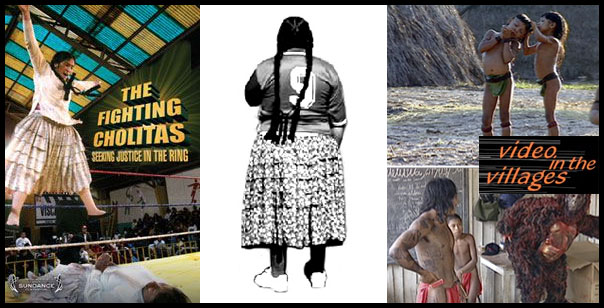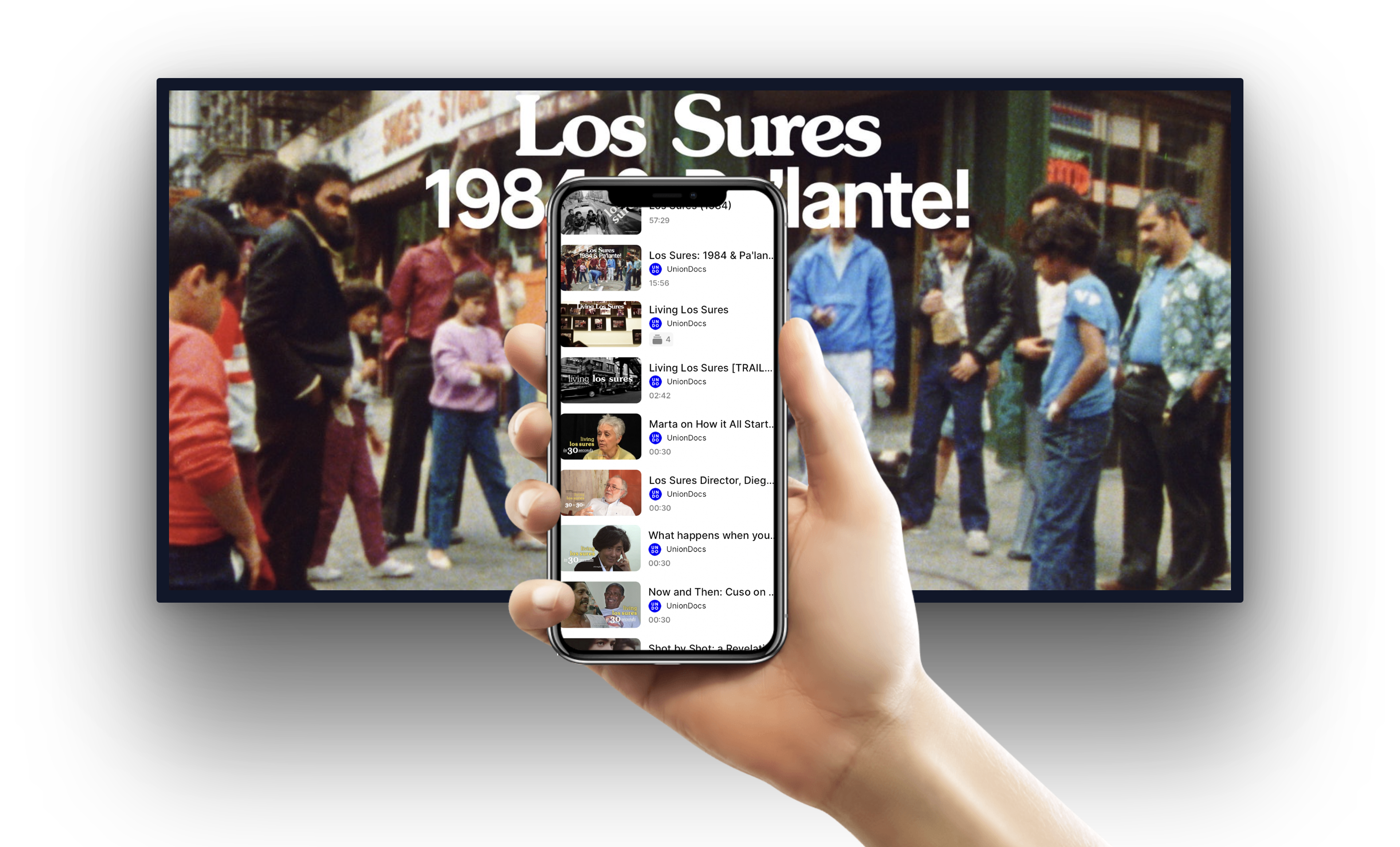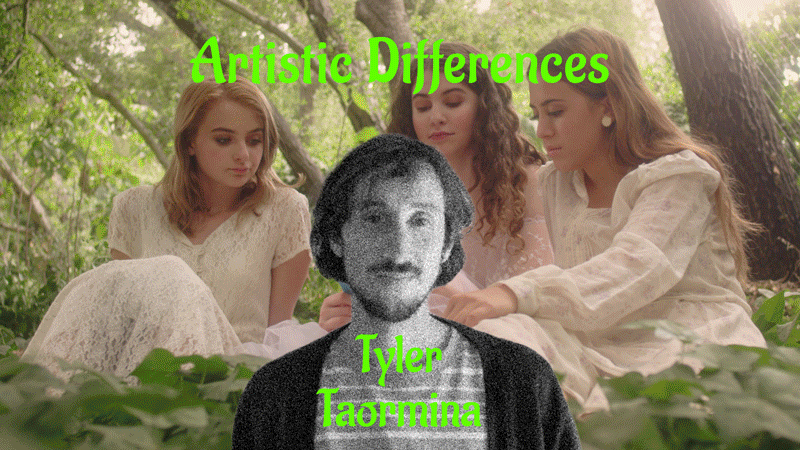

The Fighting Cholitas and Daritidzé, Trainee Healer
June 17 | 7 pm
One film follows indigenous women wrestlers in Bolivia. The other captures an initiation ceremony in Brazil. Together, this program elicits questions about community, ethnography and media authorship.
Directed by Mariam Jobrani
[quicktime width=”360″ height=”270″]http://uniondocs.org/docbodega/trailers/cholita.mov[/quicktime]
“..irresistible..”
Kenneth Turan, LA Times
“..amazing..”
Kim Adelman, indieWIRE
Best Documentary Awards: NYC Shorts Festival, Aspen Shorts, Kansas City Jubilee, Nashville Film Festival, Atlanta Film Festival
Sundance Honorable Mention Award
THE FIGHTING CHOLITAS is a documentary short about a group of bold and fierce female Bolivian wrestlers. These indigenous, Indian women jump into the rign every Sunday in their traditional, vibrant multilayered skirts and perform the acrobatic maneuvers of Lucha Libre (a blend of Mexican and American professional wrestling). THE FIGHTING CHOLITAS documents this weekly fight and goes behind the scenes to find out who these women are and what draws them to this unusual sport.

From the Video in the Villages Series
By Divino Tserewahú
[googlevideo]http://video.google.com/videoplay?docid=-8195096223596112828[/googlevideo]
RUBEN CAIXETA DE QUEIROZ
Assistant Professor of Anthropology at the Federal University of Minas Gerais and co-director of the Documentary and Ethnographic Film Festival FORUM.DOC
From Video in the Villages Exhibition: Through Indian Eyes
In 1987, in the city of São Paulo, the Project Video in the Villages was born as a branch of the activities of the Centro de Trabalho Indigenista (Centre for Indigenous Advocacy). The project’s aim was to encourage Indians to make and observe their own image, in addition to forming a network for the exchange of experience among the various indigenous groups. This experience particularly focused around the field of politics, i.e. on the process of organization and struggle the Indians were involved with in the search for their territorial rights, in search of the ethnic recognition in the face of a hegemonic society and the colonizing interests surrounding the sphere of the Brazilian State integration policy.
Indeed, in a country in which both the left and the right credit a giant TV network with a vital contribution towards creating this national identity – a TV company that, through its programmes transmitted to the four corners of the country, takes the accent and the existential problems of a São Paulo or Rio middle class to the eyes and ears of even those who inhabit a village in the depths of the Amazonian forest –, a Project addressing, in the first instance, the creation of the conditions necessary for the expression of particular ways of life through image and sound, and, in second place, to the training of indigenous film-makers, is certainly worthy of note.
Nonetheless, neither the execution of this proposal, nor its acceptance by the public have ever been straightforward. On the one hand, was the fear that the Indians (once again) were not capable of mastering the audiovisual language and would offer a low “quality” product and, on the other, that the video (the image, the television) introduced in the midst of indigenous communities would function as a disintegrating virus upon the original cultural tradition. In reality, both fears concealed and conceal an old prejudice that is always present in western society, in this case Brazilian society, that, at the same time, alleges the Indians’ “natural” incapacity (for thought and the arts) and states as universal, White ¹, or non-Indian, values and aesthetics.
In 1997, ten years after the Video in the Villages Project was created, in the city of Belo Horizonte took place the first edition of the FORUMDOC.BH Documentary and Ethnographic Film Festival). Nothing more perfect than to imagine this event presenting a retrospective look at the works carried out by that Project, debate with Vincent Carelli and Dominique Gallois the ideas and practices of this innovator project in Brazil of the use of video by the indigenous communities as a tool for valuing ethnic identity and as a resource in the conquest of their rights. In one of the debates that followed the projection of the videos, we remember that one of the spectators posed precisely the question of the legitimacy of taking the Indians technical and ideological equipment from the western world and if this would not corrupt their original forms of communication, based on oral tradition.Vincent Carelli replied demonstrating that, for good or for bad, much more for bad, an infinity of “products” and microbes had been taken to the Indians by the Whites, starting with the axe and going through the epidemics; the truth being that the video equipment represented just one more of them, and not among the worst. To the contrary, the intention was that it would provide a weapon in the hands of the Indians against the threat of their physical and cultural destruction that has always hung in the air since the first contact with the White man.A second question, this one more indignant, was presented by another viewer about “Jungle Secrets” (1998): he saw in this video produced by the Waiãpi Indians a pastiche of works like the film Alien. In reality, the Waiãpi had seen this film, as Dominique Gallois replied, and had much appreciated it, just as other indigenous groups are hooked on films acted out on the basis of the martial arts like Kung Fu or Bruce Lee. In both questions, the same fear was present: the Indians should not be corrupted by our technologies and aesthetic conceptions, and, at the same time, should be shown or should show what we magine to be the their essence: bearers of feathers, bows and arrows, walking in an integrated way in the forest, or, warriors, not to mention their lazy and treacherous natures. As if we were permitted to copy from others, while the Indians were left with the place of the repetition of everything they always were, or worse, what we imagined that they were ².
However, it is evident that this kind of concern has never had a place in the environment of “Video in the Villages”, since, as I quote elsewhere (Gallois and Carelli apud Queiroz, 1998: 44-45), this Project, affected by the prospect of a certain hermeneutic or dialogic anthropology, “part of the premise that indigenous identities are, today, more disseminated than exclusive, built from fragmented traditions and, above all, from transcultural influences. On the other hand, the anthropology of the ethnic movements has witnessed the fact that the most efficient form of strengthening a group’s autonomy is to permit that it recognizes itself, standing out from the others, in a collective identity. In this dynamic process, the reviewing of a self-image and the selection of its cultural components result in a work of constant adaptation. Culture – that does not just consist of traditions – only exists as a movement, fed by contact with “otherness.”
Seeing the films and reading the texts produced in the context of the Video in the Villages Project, we find an explicit criticism of two kinds of thought: one “archivist”, the other “relativist”. The first case challenges the kind of recording of images and collating of information that aims to “conserve” them in libraries and museums. To the contrary, it demonstrates, indigenous wisdom is respected and multiplied while it is put in action, and in permanent construction in such as way that “tradition” is seen as a creative and adaptive process.
In the second case, the criticism of radical relativism threatens a comfortable position that protects the ethnologist and the filmmaker behind their notebook or camera. In a different way, rather just observing, this Project seeks to build a communicative process in which it is for the anthropologist or filmmaker to gather up indigenous practices and patterns of thought and transmit them to hegemonic society, but their role is also the challenge of offering the Indians information about western society, respond to their demands for intervention, introduce into their villages the modern techniques that are useful for their projects. In other words, more than observer, this new prospect, the role of intercultural interpreter is attributed to the anthropologist-filmmaker.
It seems clear to us that a political concern is at the root of this Project, that cannot be considered as a mere kind of video record. Far from wanting to separate aesthetics from politics, nonetheless, we can say that this double combination is presented in distinct doses in Video in the Villages: in an initial grouping of their films the political and ethical dimension stand out in relation to the aesthetic dimension, while in a second series the opposite is shown. We will quote as example of the first kind of video the titles “We gather as a family” (1993), “Signs don’t speak” (1996) e “It’s now or never!” (1998). During a process of ethnic affirmation or in a situation of conflict over land tenure, where an unjust struggle between Whites and Indians can be seen, where a part of the former has control over the country’s means of communication and system of government, where a part of the latter hardly speaks Portuguese, when they are so requested, anthropologists and film-makers, have the duty to place their influence and their technical equipment at the disposal of the weaker part, in favor of the Indians. In this context Video in the Villages is a – necessary – activist project, that has an obvious place in activist cinema, broadly present in the history of the documentary.
However, a “political option in favor of the weakest” is not enough to resolve all the ethic problems involved in a kind of project with the use of audiovisual resources together with indigenous populations on its agenda. On the shoots there are always almost insurmountable dilemmas: What to show and what not to show the Whites? What to dissimulate and what not to hide? How to simplify to help understand what is said or enacted? How to carry on with these personal experiences and how will they affect the indigenous communities portrayed (filmed), both in their internal composition and in their relation with the outside world, whether this be the world of the Whites or that of other indigenous communities? Such question appeared, for example, in the productions concluded among the Xavante of Mato Grosso and the Waiãpi of Amapá. For this very reason it was that, in a rehearsal, Vincent Carelli (1995: 50), faced with the incompatibility between the indigenous “eye” (language, aesthetics) and that of the western public, thus justifies the conception of two products: one destined for the indigenous and the other to the greater public. Nonetheless, if the linguistic, cultural and aesthetic specificities on the Indians‘ side seem obvious to us, as we consider just the attempt to produce something that attends this universe, we think it is much more difficult and questionable to carry out a video production that addresses the tastes of the greater public from the indigenous narratives and styles. In the attempt to satisfy the taste of this public, the videos from the first phase of the Project are filled with a good dose of ingredients from classical cinematography ³. In fact Carelli himself (1995: 50) comments: “I was always concerned in producing something attractive for the public: that is to say, beautiful photography, cuts in the movement, an accelerated editing for an audience used to a visual culture designed in the TV style. A touch of humor is always essential.”
In disagreement with this option of the works of the first phase of the Video in the Villages, we argued in an article lready quoted here (Queiroz, 1998: 48) that we should not seek the accommodation of the indigenous aesthetics within that of western society, but, on the contrary, we should seek a confrontation between these different styles, between the different points of view, that it is important to force the western world to recognize that there are other ways of perceiving the world, of living and of thinking, and, as a result, there is another way of making films beyond those so common-place on television, the scientific description, the report, the sticking, pasting and blending of video-clips, publicity and video-art.
In the light of this partial criticism, we see with satisfaction the appearance of a second phase in the Video in the Villages Project, in which that exaggerated concern over attracting the public was left to one side, i.e., the function of the spectacle is no longer the central thread in their production. In this new harvest of videos we draw attention to masterpieces, such as “The Rainy season” (2000) and “Shomõtsi” (2001) 4. Here, without exaggeration, we rediscover some traces, shots, and spaces of film-makers such as Antonioni or Ozu. In other words, filming the waiting time and the empty space become such as, if not more important than filming the action. And it is thus that the indigenous reencounter the west and the east, no longer in classic cinema but in one that is much more reflexive, in modern cinema. I would risk saying that this change in the narrative framework and cinematographical conception has resulted from the entrance of Mari Corrêa in the Project, a documentary filmmaker trained in France under the influence of modern cinema and of film-makers such as Jean Rouch 5. Nonetheless, there is another reason for the appearance of a new phase in the Project: the majority of the videos begins to be made by the very Indians who were trained in the Project’s workshops. In other words, the Indians absorb the information with respect to techniques and a film culture and use it in their local context to build pieces that are not only carriers of an internal voice, but, I would say, of a body in movement, of an indigenous way of thinking.
We don’t know if these videos made by the Indians excite the greater public, but I think that their task is less to entertain and inform than to translate another world lived, thus possible, but also to imagine a world. It is true that even “modern cinema” never fell into grace with the large public, much less that of television, but, at least (would this be a consolation?), it makes us think and not treat the public as mediocre. In fact, in the majority of times, as Jean-Louis Comolli reminds us, the spectator is imagined as a childish being, “to whom are offered visual and sound clapboards, that is taken by the hand to be guided, that is disdained either by excesses of redundant explanations, or by the dissimulation of causalities and complexities… Let us say, then, that it is a spectacle and not cinema. The spectator that we suppose, to the contrary, […] is a viewer perfectly apt to see, to feel, to understand, that is able to do something with what he/she sees. A spectator that is also a citizen, responsible, being aware of their responsibility” 6. In the Project’s turnaround, in taking the spectator seriously, and, consequently, taking the system of indigenous thought seriously, we observe that Video in the Villages have left the spectacle to one side in favor of the risk of the real.
In placing the spectacle in second plan, it is the day-to-day situations and the weak time that take the scene. In “Kinja Iakaha, a day in the village”(2003), “From the Ikpeng children to the world” (2001), “Shomõtsi” (2001) and “The rainy season” (2000), we can witness the abandonment of a predetermined political or aesthetic project, in such a way that in these videos, as Jean-Louis Comolli (2001) would say, the women and the men who agree to take part in the situation and in the relation established by the film, interfere in both and transfer to them, with distinction, “all the determinations and difficulties, the weight and grace they carry, their shadow”. What the indigenous filmmaker shoots, like every good documentary maker, is “also something that is not visible, or filmable, it is not made for the film, is not at our reach, but is found there with the rest, dissimulated by the light itself or blinded by it, beside the visible, under it, outside the field, outside the image, but present in the bodies and among them, in the words and between them, in the entire cloth woven by the film machinery. To film real men in a real world represents being taken over by the disorder of ways of life, by the undividable in the world, what from the real is determined to fool predictions” (Comolli, 2001: 105-107). The impossibility of a script. The need that the indigenous film-makers in the Video in the Villages Project convey to the spectator is not just another eye, not just the minority part of a world, the cursed part, but also another ontology. All they need is to be given a good video camera and minimal preparation to manipulate this technical instrument, and they reveal to us another possible world, perhaps invisible to the west, but imaginable by the reflective spectator that is prepared to place in doubt their values and bodies before other values and other bodies.
The viewer of the Video in the Villages made by the Indians, like that of modern cinema, should never expect a “destined” character and a finished, unique, world, since, to quote the sociologist Pierre Bourdieu (1998: 11-12), there the simplistic and unilateral images are substituted by a complex and multiple representation, founded in the expression of the same realities in different and, at times, irreconcilable discourses; and in the style of novelists such as Faulkner, Joyce or Virginia Wolf, we need to abandon the single, central, dominant, in essence, almost divine point of view, in which the observer and also the reader (the cameraman and also the viewer) is generally placed, to delve into the plurality of coexistent and “at times directly concurrent” points of view.
As Ismail Xavier said about the cinema of Eduardo Coutinho, but which is also valid for Video in the Villages of the last harvest, in particular “Shomõtsi” (2001) and “The Rainy Season” (2000), “the duration is the condition by which a sensitive ‘eye’ and ‘ear’ can be composed, capable of satisfying the demands of a phenomenological description, with an closeding for the happening and an understanding that is not propped up by predefined categories” (Xavier, 2003: 59). In the most important work on the Brazilian documentary, Jean-Claude Bernardet (2003: 282) said that in Brazil direct cinema brought to light a verbal universe previously unknown on the screen, in which to the words of the speakers, to the written dialogues of the characters of fiction, was counter-posed a multiple Portuguese spoken outside the realms of the civilized norm, where the viewer could, at last perceive the range of accents, of prosodies, of syntaxes. At this moment, the critic did not yet have in his hands the new films produced by the indigenous film-makers, since in them not only the speech (accents) are others, but the world is another, it is no longer that fiction of the powerful, as Deleuze was to say about the films Pour la suite du monde by Pierre Perrault and Moi – un noir by Jean Rouch. If the Brazil of today is impregnated with the “all-fiction of everything” of the TV soaps and reality shows, in it there is still a place for the fabling imagination of the characters and film-makers such as those in the Video in the Villages project. In the year 2004, when we lost one of our totemic ancestors, Jean Rouch, as he himself liked to call Vertov and Flaherty, we see, in compensation, a showing of films by indigenous film-makers in Rio de Janeiro, since, as it was Jean Rouch himself (1979) who declared: “Tomorrow will be the age of the autonomous color video, of video montage, of the instantaneous restitution of the recorded image, in other words, of the joint dream of Vertov and Flaherty, of a camera so participative’ that it is automatically passed to the hands of those who up until now have been in front of it. Thus, the anthropologist will no longer have the monopoly of the observation, he/she themselves will be observed, recorded, together with their culture.”
____________________
1. To be fair, among the “Whites”, we can always find those who state, like the poet Rimbaud”I is another” or the film-maker Jean Rouch, Moi, un noir and, thus, make the others the essence their art, It is also worth remembering that certain intellectuals and western artists have given up the male-wastern- European aesthetic standard and “quality” in favor of noise, of the unthinkable, the un-measurable, the fault, as the artist James Ensor says in a banquet in his honorpromoted by La flandre Liteéraire in 1923: “Yes, thefaults are the qulities, and the fault is superior toquality. Quality means uniformity in the effort to reachcertain common perfection, accessible to all. The fault is,thus, the multiple; it is life and reflects the personality,everething and must needs save the work.”
2. This reminds us of an anecdote in which several ofFUNAI ( the official organ of indigenous affairs) in theirworthy work with the “Iisolated Indians”, from time totime, went trough their villages collecting certainobjects such as aluminium saucepans that the Indianshad maneged to obtain in their non permanent contactwith the world of the Whites. Between the devil andthe deep blue sea, it is not rare for these same Indiansto be hassled by evangelical missionaries propagatingthe “world of god” among them and calling them toabandon their “barbarian customs”.
3. This is especialy the case for the videosmeeting ancestors (1993), Yãkwa the banquetof the spirits (1995), m oranyngava (1997),Morayngava (1997) and Jungle secrets (1998).
4. These and other videos made by the Indians wereawarded in important documentary film festival. Thereason for this, we belive, is not due to any criterionestabilished by the jury formed that could be based ina policy of ethnic affirmation, but on that of simplemerit in terms of aesthetic beuty and on content.
5. It should be clarified that before 1999 the editing ofmost of the “videos in the villages” was signed by TutuNunes, whereans Mari Corrêa signs the editing of morerecent work.
6. This quote, translated by us, is a text byJean-Claude Comolli published in a review organizedby Maria José Mondzain (2002) as a tribute to frenchphilosofer Jean-Toussaint Desanti, recently desapeared,who develloped for arts and sciences the rich conceptof Voir Esemble.Bibliographic ReferencesBERNARDET, Jean-Claude. 2003. Cineastas e Imagens do Povo. São Paulo,Editora Companhia das Letras.BOURDIEU, Pierre. 1997. A Miséria do Mundo. Petrópolis, Editora Vozes.CARELLI, Vincent. 1995. “O programa e os documentários: duas dimensõesdistintas e complementares do projeto Vídeo nas Aldeias.” Mimeo.COMOLLI, Jean-Louis. 2001. “Sob o risco do real”. In Catálogo doForumdoc.bh.2001 – 5o Festival do Filme Documentário e Etnográfico.Belo Horizonte.MONDZAIN, Marie José. 2002. Voir ensemble. Autour de Jean-ToussaintDesanti. Paris, Gallimard.QUEIROZ, Ruben Caixeta de. 1998. “Comunicação intercultural: Vídeo nasaldeias”. In Geraes. Revista de Comunicação Social. N. 49. pp. 44-49.ROUCH, Jean. “La caméra et les hommes”. In FRANCE, Claudine. Pour uneanthropologie Visuelle. Paris-La Haye-New York.XAVIER, Ismail. 2003. “Indagações em torno de Eduardo Coutinho e seudiálogo com a tradição moderna.” In Catálogo do Forumdoc.bh.2001 –5o Festival do Filme Documentário e Etnográfico. Belo Horizonte.






